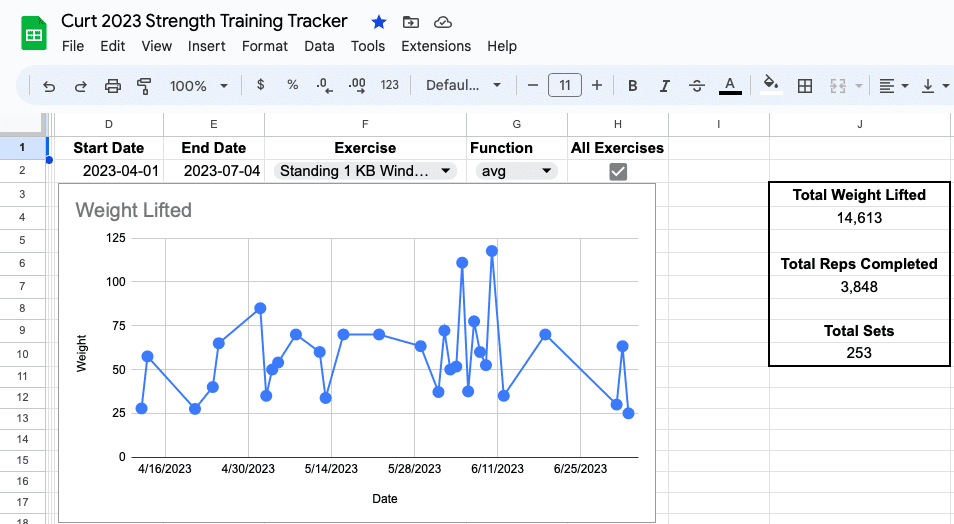Workout Tracker
How To Log And Track Supersets With Your Workout Tracker
Supersets are a great way to get the most from every rep you lift, curl, and press. If you’ve done them before you know what I mean. Simply skipping the rest between sets of exercises for opposing body parts hits differently than doing each exercise for the prescribed number of reps before moving on.
Entering the supersets you do in your workout log and tracking your progress is done a little differently. If you don’t record them properly it makes it impossible to recall them to use in the future. Tracking your progress is difficult too.
In this article I’ll show you how to track and log superset exercises using your workout tracker. Knowing the best way to do this will help you more accurately record them and track your progress.
Before we get to that, let’s go over what a superset is and how they’re done.
What Are Supersets?
A superset is 2 exercises done without rest. You only take a break after doing the 2nd exercise in the set. They’re typically made up of exercises with opposing muscle groups – chest/back, biceps/triceps, and quads/hamstrings are the most common pairs. You can also do supersets alternating upper and lower body exercises.
You don’t typically do supersets with exercises that train the same muscles, for example push ups and bench presses. This doesn’t allow you to rest the muscles you’re training between sets, which is what gives supersets their benefits.
Here’s an example superset using curls and triceps extensions.
- Biceps curls – 10 reps
- Immediately followed by
- Triceps extensions – 10 reps
- Rest than repeat starting with the next set of biceps curls
Now that you know what they are, let’s get to why you’re reading this article and learn how to enter supersets in your workout tracker.
How To Log Supersets With Your Workout Tracker
Option 1 – Enter the superset as one exercise.
This is simply done by writing both exercises on the same line of your tracker and separating them with / symbol.
Here’s a screenshot that shows you what I mean.

Here’s how you log supersets as one exercise.
This is my favorite way to record them. Here’s why.
When you see 2 exercises on the same line like this it immediately tells me that I did them together. Even if I’ve never seen the workout before. It also makes tracking my progress easier with a graph since the exercises I do as a superset are tracked as one.
Here’s how you fill out the rest of the information when you record supersets this way.
Your rest between sets
When you write out supersets this way is for the amount taken after the second exercise. Don’t worry about writing down the few seconds you have to take between the first and second exercise to change weights, equipment, etc. It isn’t long enough to affect your performance or throw off the intensity of the superset.
Total the weight you use for each exercise
Say you’re supersetting biceps curls and triceps extensions. You’re curling 50 lbs and doing extensions with 75. In the ‘weight’ section of your tracker you’ll record 50 + 75 = 125 lbs – the total amount of weight used – for every superset you do.
Enter the total number of reps you do each superset too
Just like you did for the weights you used. I’ll use the example of a superset consisting of biceps curls and triceps extensions to explain. If you were able to do a set of 10 curls and 12 extensions you’ll enter 22 (10 + 12) in the ‘reps’ area of your tracker for this exercise.
Option 2 – Record your superset as 2 exercises
If you choose this method you’ll enter your exercises on separate lines in your workout log. Just like you do a regular workout where you rest between every set before moving onto the next exercise.
A benefit of tracking supersets this way is that you’ll be able to see how many reps and what weight you used for each exercise.
If you choose this method, you may want to also add A1 next to the first exercise and A2 before the second exercise. This A1/A2 notation is commonly used by strength coaches, trainers, and people like you and me to signify that the exercises are done as a superset. The A means they are part of the same group. The numbers 1 and 2 tell you what order they’re done.

Logging supersets using 2 lines. Note the 0 sec rest period for the 1st exercise
Here’s how you’ll enter the reps, weight, and rest between sets using this method.
How to record your rest between sets
The first exercise in your superset will have a rest interval of 0 seconds. Makes sense, right? Since you are resting as close to 0 seconds between exercises this’ll be what you record. If for some reason you end up taking longer than say 15 seconds between exercises I’d right the actual number down. Less than that doesn’t matter. I’d make a note in my post-workout notes (link) as to why the extended rest period happened too.
The 0 seconds between sets is also a good way to see that you did these exercises as a superset too…
You’ll record your time between supersets in the rest section for the second exercise you’re doing.
Tracking reps for each exercise in the superset
This won’t be any different that the way you record reps per set normally. If you did 8 reps for biceps curls and 10 reps of triceps extensions you’ll enter 8 and 10 for each exercise. This lets you see how you do with each exercise but isn’t always as easy to track in terms of how you’re performing overall with this superset.
How to record the weight you’re lifting when you log your supersets
You’ll do this the same way you logged your reps. The weight you lifted for each exercise is recorded separately, in the space you have for that particular exercise. Doing this helps you track your performance with each exercise and see how you’re doing at each.
Frequently Asked Questions
Does A Superset Count As One Exercise Or Two?
I count them as 2 exercises when I’m writing a workout. The only difference between supersets and regular, straight sets is when you rest. You’re still doing 2 different exercises.
How many sets is a superset?
I count them as one set. This is because there’s zero, or as close to it as possible, rest until the second exercise is done.
What is a superset of 3 exercises?
These are often referred to as a triset. Here you’ll add in an exercise for a third muscle group that doesn’t train the same muscles as the first 2 exercises.
An example of a triset is: dumbbell laterals, biceps curls, and triceps extensions. Each exercise is done for the prescribed number of reps without rest until the last exercise, triceps extensions is completed. You then rest and repeat for however many sets you’re doing.
Streamline Superset Tracking with Our Workout Tracker
When it comes to tracking supersets, our workout tracker that seamlessly works with Google Sheets is your ultimate companion. We’ve designed this tool to not only simplify the process but also provides you with insights into your progress and performance.
Track Supersets Your Way
Whether you prefer to group them as a single exercise or log them individually, our tracker can record both. If you want to bundle them as one, merely input both exercises on a single line, separated by a “/” symbol. Alternatively, if you choose to log them separately, you can easily create a clear demarcation for each exercise in the superset by using the A1/A2 method I write about under option 2 in this article.
Every Superset Is Saved For You
What sets our tracker apart is that every superset you do gets saved into your workout database. This way it’s always there for you to use. This is super helpful when you’re creating a new workout. In just a few clicks, you can effortlessly add your favorite supersets in seconds.
See How Your Superset Workouts Are Progressing
Graphs and charts offer an insightful visual representation of your journey. Our tracker graphs your progress with supersets over time. In every possible way. From the number of reps done, weight lifted, exercises you do most often, and more.
Here’s a few screenshots so you can see what I mean.


Screenshots from Stayfitcentral’s Weight Training Tracker
Revolutionize Your Tracking Experience
Embrace the transformative potential of our Google Sheets add-on workout tracker. By seamlessly managing your supersets and tracking progress, you’re setting the stage for breakthroughs. Your fitness journey becomes more than just a routine – it becomes a measurable, dynamic, and motivating adventure. Maximize your potential and redefine your workout tracking with the power of our innovative tracker.
Track Your Supersets And Watch Your Progress Soar
Now you know the 2 best ways to log supersets in your weight lifting tracker. Try out both methods to see which works best for you. No matter which one you settle on, you’ll quickly see that tracking and measuring your progress is easier than any other.

